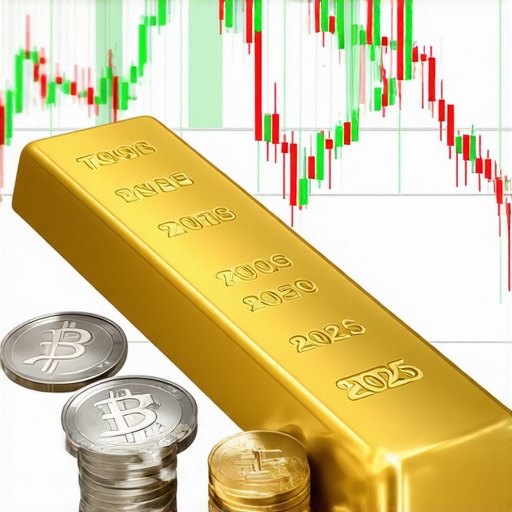Understanding the Evolving Role of Gold in Modern Investment Strategies
As global financial markets become increasingly complex and volatile, the role of gold as a diversifying asset gains renewed significance. In 2025, investors are seeking stability amidst economic uncertainties, making gold a pivotal component of a resilient portfolio. Its unique properties as a tangible, non-yielding asset offer a counterbalance to traditional equities and bonds, especially during periods of market turbulence and inflationary pressures.
Why Gold Remains a Cornerstone for Diversification in 2025
Historically, gold has demonstrated a low correlation with other asset classes, positioning it as an effective hedge against inflation and currency devaluation. According to the white paper by Gold Institute, during economic downturns or geopolitical crises, gold prices tend to outperform traditional assets, preserving wealth when it matters most. This characteristic underscores its strategic importance in constructing a diversified portfolio that can withstand macroeconomic shocks.
Complexity in Gold Investment Types and Their Strategic Roles
Investors in 2025 are exploring a spectrum of gold investments, from physical bullion and coins to ETFs, mining stocks, and futures contracts. Each offers distinct risk-return profiles and liquidity considerations. For instance, gold ETFs provide liquidity and ease of access, while physical gold ensures tangible security. Developing a nuanced understanding of these instruments is crucial for optimizing diversification benefits and aligning with individual risk tolerances.
How Global Economic Trends Shape Gold’s Protective Capabilities
In the context of rising inflation, fluctuating interest rates, and geopolitical tensions, gold’s role as a hedge becomes more pronounced. The report by IMF highlights that central banks are increasing gold reserves, signaling confidence in its long-term value preservation. These macroeconomic dynamics influence gold’s price trajectories and underscore its strategic relevance in a diversified investment approach for 2025 and beyond.
What Are the Nuanced Challenges of Incorporating Gold into a Diversified Portfolio in 2025?
Despite its advantages, integrating gold requires careful consideration of timing, valuation, and market liquidity. Investors must navigate potential price volatility, the costs associated with physical storage, and the implications of regulatory changes. Advanced investors often employ technical analysis and market trend assessments to optimize entry and exit points, maximizing the protective benefits of gold during turbulent periods.
For further insights on optimizing your gold investments, explore our detailed strategic framework for 2025 and consider engaging with professional financial advisors to tailor a gold-inclusive portfolio aligned with your long-term wealth objectives.
As the landscape of global finance continues to evolve, staying informed about shifts in gold demand and supply is imperative. You can deepen your understanding by reviewing the latest market analysis and adjusting your strategies accordingly.
Unlocking the Potential of Gold in 2025: An Expert’s Perspective on Strategic Investment
As we navigate the financial landscape of 2025, understanding the intricacies of gold investment becomes paramount for sophisticated investors seeking to optimize their portfolios. The evolving macroeconomic environment, characterized by inflationary pressures and geopolitical tensions, necessitates a nuanced approach to gold allocation. Recent analyses, such as those documented by the top investment strategies, emphasize the importance of blending physical gold holdings with derivatives and innovative financial instruments to hedge against volatility.
Advanced Techniques to Maximize Gold’s Protective Role
Investors are increasingly leveraging technical analysis, macroeconomic indicators, and geopolitical risk assessments to fine-tune their gold entry and exit points. For example, chart patterns and moving averages can signal optimal timing, while monitoring central bank policies provides insights into potential price shifts. Incorporating gold futures and options into a diversified strategy allows for greater flexibility and risk management, especially when market conditions turn unpredictable. To deepen your understanding, explore our guide on using gold futures and technical analysis effectively in 2025.

Are We Underestimating the Long-Term Resilience of Gold?
One critical question that seasoned investors ask is whether gold’s historical resilience truly captures its potential in the face of emerging economic challenges. According to a comprehensive report by the analysts at Gold Investment Research, gold’s ability to preserve wealth during global downturns is rooted in its intrinsic properties and the shifting preferences of central banks, which continue to increase their gold reserves. This trend underscores the importance of maintaining a strategic, long-term perspective on gold investments, especially considering the evolving landscape of monetary policy and international trade.
For investors aiming to build resilience, diversifying with gold ETFs and mining stocks can complement physical holdings, providing liquidity and exposure to the sector’s growth potential. For a comprehensive overview of the best options, visit our detailed review on top gold investment options for 2025.
What Are the Key Indicators That Will Signal a Turning Point for Gold in 2025?
Given the complex interplay of global economic factors, identifying pivotal indicators is crucial for making informed decisions. Metrics such as inflation rates, real interest rates, and the strength of the US dollar serve as vital signals. Additionally, geopolitical developments and central bank policies can rapidly alter the supply-demand dynamics of gold. Staying vigilant to these indicators, coupled with expert market analysis, enhances your ability to capitalize on emerging opportunities and mitigate risks.
If you’re interested in refining your investment approach, consider exploring our comprehensive resources on developing a long-term gold portfolio and stay ahead of market trends.
Engage with us by sharing your insights or questions in the comments, or explore our extensive library of articles to further deepen your mastery of gold investing in 2025.
Harnessing Advanced Analysis for Gold’s Long-Term Resilience in 2025
As the global economy continues its intricate dance between inflationary pressures, geopolitical tensions, and shifting monetary policies, the role of gold as a cornerstone of strategic investment becomes ever more nuanced. Experts emphasize that understanding the multifaceted drivers behind gold’s demand—ranging from central bank reserve policies to emerging market needs—is essential for sophisticated investors aiming to optimize their portfolios.
Recent research published by the Gold Institute points to a significant increase in central bank gold holdings, a trend driven by the desire to hedge against currency devaluation and geopolitical risk. This shift reflects a broader recognition of gold’s intrinsic value as a non-sovereign store of wealth, especially amid the persistent uncertainties in global trade and finance. Consequently, investors must incorporate macroeconomic indicators such as real interest rates and currency strength into their analytical models, enabling more precise timing of entry and exit points.
How Do Sophisticated Investors Use Quantitative Models to Forecast Gold Trends?
Advanced market participants leverage quantitative techniques—such as machine learning algorithms, sentiment analysis, and economic scenario simulations—to decipher complex patterns in gold price movements. These models integrate a multitude of variables, including inflation expectations, currency exchange rates, and geopolitical event probabilities, to generate probabilistic forecasts. For instance, a study by the Quantitative Finance Journal highlights that models incorporating sentiment analysis of geopolitical news outperform traditional technical analysis in predicting short-term price swings.
Implementing such models requires access to high-quality data, robust computational infrastructure, and a deep understanding of market fundamentals. Yet, when deployed effectively, they serve as invaluable tools for navigating the unpredictable terrain of gold markets in 2025, helping investors to make data-driven decisions that align with their risk appetite and strategic objectives.
Integrating Sophisticated Hedging Strategies with Gold to Manage Portfolio Risks
In practice, blending physical gold with derivatives such as options and futures allows for customized risk management tailored to evolving market conditions. For instance, purchasing put options on gold futures can provide downside protection during periods of heightened volatility, while futures contracts enable precise exposure adjustments without the logistical challenges of physical storage. Additionally, employing dynamic rebalancing techniques—adjusting gold allocations in response to macroeconomic signals—can enhance resilience against adverse shocks.
Furthermore, integrating gold-related exchange-traded products (ETPs) with active portfolio management strategies facilitates liquidity and flexibility, vital in fast-changing environments. According to a comprehensive analysis by Financial Times, investors who employ multi-layered hedging tactics tend to outperform less sophisticated approaches during economic downturns, underscoring the importance of a layered risk mitigation framework.
What Are the Emerging Risks and How Can Investors Prepare for Unexpected Market Shifts?
Despite the strategic advantages, sophisticated investors recognize that unforeseen events—such as sudden geopolitical escalations, policy reversals, or technological disruptions—can rapidly alter gold’s market landscape. Maintaining agility through a diversified toolkit of hedging instruments, continually updating macroeconomic models, and staying informed via real-time news analytics are crucial practices. Engaging with expert financial advisors and participating in professional forums can further refine strategies, ensuring preparedness for the unpredictable future of gold investing in 2025 and beyond.
To deepen your expertise, explore our comprehensive resources on building resilient gold portfolios for 2025 and consider collaborating with specialized financial consultants who can tailor sophisticated strategies to your unique investment profile.
The Role of Gold in a High-Tech Global Economy: Navigating New Frontiers
As technological innovation accelerates, the demand for physical gold and gold-backed digital assets is evolving, reflecting shifts in both investor preferences and geopolitical strategies. The integration of blockchain technology with gold ownership—through tokenized gold—introduces unprecedented transparency and liquidity, appealing to a new generation of sophisticated investors. According to a recent report by the CryptoResearch Institute, these digital representations of gold could revolutionize how portfolios are diversified in the coming decade.
How Can Artificial Intelligence Enhance Gold Market Forecasting?
Artificial intelligence (AI) and machine learning are increasingly employed to analyze vast datasets—ranging from macroeconomic indicators to geopolitical developments—allowing investors to forecast gold price movements with higher precision. Advanced models incorporate sentiment analysis from news outlets, social media, and policy announcements, providing a real-time pulse on market shifts. The Quantitative Finance Journal highlights that AI-driven predictions outperform traditional methods, especially during periods of heightened volatility, empowering investors to optimize timing and hedge effectively.
Expert Question: How Do Geopolitical Risks Specifically Influence Gold’s Strategic Allocations?
Geopolitical tensions—such as regional conflicts, trade disputes, and diplomatic escalations—directly impact gold’s appeal as a safe haven. Experts advise that dynamic geopolitical risk assessments should be integrated into asset allocation models, with particular attention to emerging hotspots. For example, recent conflicts in Eastern Europe and Asia have prompted central banks and institutional investors to increase gold reserves, as noted in the World Bank’s Geopolitical Risk Report. This trend underscores gold’s strategic importance in mitigating geopolitical uncertainties and preserving wealth during turbulent times.
What Are the Cutting-Edge Techniques for Integrating Gold into Multi-Asset Hedging Portfolios?
Sophisticated investors utilize a combination of options strategies, futures contracts, and tokenized assets to hedge against inflation, currency fluctuations, and market downturns. For instance, protective puts on gold futures can serve as insurance during sudden market shocks, while dynamic rebalancing based on macroeconomic signals ensures optimal risk-adjusted returns. Additionally, employing algorithmic trading systems that adapt to real-time data enhances agility. According to Financial Times, such layered approaches are increasingly vital for resilient wealth preservation amid unpredictable global shifts.
To deepen your mastery of these strategies, explore our comprehensive guide on developing multi-layered hedging frameworks for 2025.

Is the Long-Term Resilience of Gold Underestimated in the Age of Digital Currencies?
While digital currencies are gaining prominence, gold’s intrinsic qualities—such as durability, scarcity, and historical stability—continue to underpin its resilience. A report by the Gold Institute emphasizes that gold’s role as a non-sovereign store of value remains unchallenged, especially as governments explore digital currencies that may introduce new regulatory uncertainties. Maintaining a strategic allocation to physical and digital gold assets can provide a hedge against the potential volatility of emerging financial technologies.
For investors seeking to future-proof their portfolios, diversifying with gold ETFs, mining stocks, and physical holdings—alongside emerging digital gold solutions—can help strike a balance between tradition and innovation. Visit our detailed analysis on building a resilient gold portfolio for 2025 and beyond.
What Are the Key Indicators Signaling a Turning Point for Gold’s Long-Term Value?
Monitoring macroeconomic variables such as real interest rates, inflation expectations, and currency strength remains essential. Additionally, tracking central bank policies, geopolitical developments, and technological disruptions offers predictive insights. For example, increases in official gold reserves by central banks or shifts in monetary policy can serve as early signals of a sustained price trend. Staying attuned to these indicators, combined with expert analysis, empowers investors to anticipate and capitalize on market shifts effectively.
To refine your strategic approach, explore our advanced resources on anticipating long-term gold trends and consider engaging with specialist advisors for tailored insights.
Expert Insights & Advanced Considerations
Strategic Diversification Enhances Portfolio Resilience
Investors should integrate gold with emerging assets like digital gold tokens, which combine traditional value preservation with technological innovation, ensuring adaptability in a rapidly evolving market environment.
Macro Indicators as Investment Guides
Monitoring macroeconomic indicators such as inflation rates, real interest rates, and geopolitical tensions enables proactive adjustments in gold allocations, optimizing risk-adjusted returns.
Advanced Analytical Techniques
Utilizing quantitative models, including machine learning and sentiment analysis, can forecast gold price movements with higher precision, aiding in timely entry and exit decisions.
Holistic Risk Management
Combining physical gold holdings with derivatives like options and futures allows for tailored risk mitigation strategies, especially during market turbulence or geopolitical crises.
Technological Integration in Gold Investment
The emergence of blockchain-based gold assets and AI-driven analytics offers new avenues for diversification and strategic positioning, reinforcing gold’s role as a resilient asset in 2025.
Curated Expert Resources
- Gold Institute Reports: In-depth analysis on long-term gold demand trends and macroeconomic influences.
- Quantitative Finance Journal: Cutting-edge research on predictive modeling and AI applications in gold markets.
- Financial Times: Insights into sophisticated hedging techniques and global economic impacts on gold.
- CryptoResearch Institute: Reports on digital gold tokenization and blockchain innovations.
- World Bank Geopolitical Risk Reports: Data-driven assessments of geopolitical risks affecting gold reserves and prices.
Final Expert Perspective
In 2025, the role of gold as a cornerstone of diversified investment portfolios is more nuanced and strategically vital than ever. Embracing advanced analytical tools, macroeconomic insights, and technological innovations enhances resilience against global uncertainties. To deepen your expertise, explore our top strategies for gold as an inflation hedge and collaborate with financial professionals to craft a bespoke, forward-looking gold investment plan. Stay informed, adapt proactively, and leverage expert insights to safeguard and grow your wealth amidst the complexities of 2025’s economic landscape.










